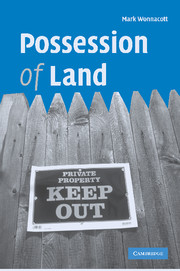Book contents
- Frontmatter
- Contents
- Preface and acknowledgments
- Table of cases
- Table of statutes
- Table of statutory instruments
- 1 Meaning of possession
- 2 Protection of possession
- 3 Possession, title and freehold land
- 4 Leases and licences
- 5 Mortgages and charges
- 6 Equity and trusts
- 7 Birth and death, dissolution and insolvency
- 8 Adverse possession and prescription
- 9 Possession judgments
- 10 Summary and conclusions
- Index
4 - Leases and licences
Published online by Cambridge University Press: 13 August 2009
- Frontmatter
- Contents
- Preface and acknowledgments
- Table of cases
- Table of statutes
- Table of statutory instruments
- 1 Meaning of possession
- 2 Protection of possession
- 3 Possession, title and freehold land
- 4 Leases and licences
- 5 Mortgages and charges
- 6 Equity and trusts
- 7 Birth and death, dissolution and insolvency
- 8 Adverse possession and prescription
- 9 Possession judgments
- 10 Summary and conclusions
- Index
Summary
Introduction
The common law of landlord and tenant is neither logical nor entirely intelligible. The reason is that there is a conceptual fissure, which runs right the way through it. We just cannot decide whether it ought to be part of the medieval law of real property or part of the nineteenth-century law of contract. The courts sometimes treat it as part of one and sometimes as part of the other.
Whether a particular problem properly lies within the domain of contract or real property should not always be too difficult to determine. Contract ought to govern issues of interpretation and the extent of obligations. Real property ought to govern issues of transmission and status.
Sometimes, however, it is not obvious whether the answer ought to lie in contract or real property, and they often suggest radically different solutions to the same problem.
Take, for example, the question of whether it is possible contractually to fetter the power to serve a notice to quit determining a periodic tenancy. As a matter of liberal laissez–faire contract law, there is no reason why this should not be possible. But, if a periodic tenancy is viewed as a piece of property, then it might be thought that the ability to determine the tenancy by service of notice to quit is inherent in the nature of the property.
The property analysis has, in fact, triumphed on this particular question.
- Type
- Chapter
- Information
- Possession of Land , pp. 50 - 73Publisher: Cambridge University PressPrint publication year: 2006



